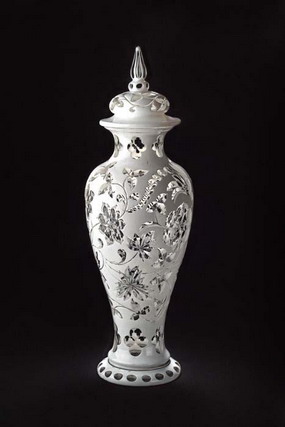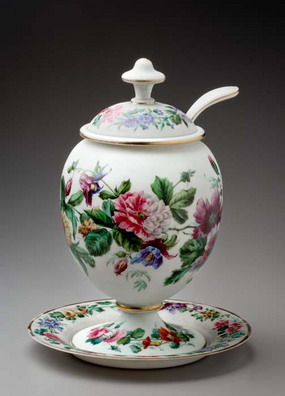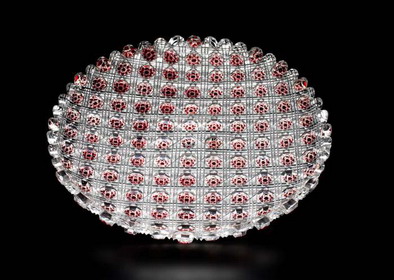第六章 19世纪下半叶玻璃器(历史风格)
公元19 世纪下半叶早期的西欧(特别是英国),致力于进行提升制作工艺美学水平的改革运动。该运动转而向历史风格寻找灵感。那些已经离开波希米亚并定居不列颠群岛的玻璃雕刻师们对新玻璃装饰方法的引入起到了极其重要的作用。在中欧,维也纳的罗伯迈(Ludwig Lobmeyr,1829—1917) 在玻璃产业享有极高的地位和声望,从公元19 世纪60 年代开始,他专门制作文艺复兴和巴洛克风格的玻璃精品;公元19 世纪70年代,他又将东方元素加入玻璃设计。在意大利,安东尼奥·塞维提(Antonio Salviati, 1816—1890)重振了传统的威尼斯玻璃艺术。在法国,世界著名的玻璃艺术家和工艺家埃米尔·加莱(Emile Gallé,1846—1904)在南希如火如荼地开展玻璃事业。公元19 世纪见证了新制造方法—玻璃压制成型技术的繁荣,这种技术首先发源于美国,而后传播至整个欧洲,在欧洲,利用这种技术进行玻璃装饰的公司主要集中在法国(巴卡拉水晶玻璃Cristalleries de Baccarat) 和英国(伯明翰和斯陶尔布里奇的玻璃工厂)。由于拥有相对便宜而质量又可靠的手工制作,故该工艺于19 世纪末被捷克所采用。
Glass of the Second Half of the 19th Century (Historical Style)
The early years of the second half of the 19th century in western Europe (and especially in England) were marked by a reform movement that strove to elevate the aesthetic level of craftsmanship. This movement turned to Historical Styles for inspiration. Glass engravers who had left Bohemia and settled in the British Isles were highly instrumental in introducing new glass-decorating methods. In central Europe, Ludwig Lobmeyr (1829–1917) had a prominent place in glass production. From the 1860s, he specialized in exquisite glass made in the Renaissance and Baroque Revival styles. In the 1870s, he expanded his glass output to include oriental patterns. In Italy, Antonio Salviati (1816–1890) strove to revive the traditional Venetian art of glassmaking. In France, the world-renowned glass artist and technologist Emile Gallé (1846–1904) was professionally active in Nancy. The 19th century saw the flourishing of a new production method – pressed, or rather mould-pressed, glass. The foremost producers of this type of glass were based in the United States. The principal companies that utilized this method of glass decoration in Europe were centred in France (Cristalleries de Baccarat) and England (e.g. glass companies in Birmingham and Stourbridge). Owing to the relatively cheap yet highly-qualified manual labour, this technology was also adopted in the Czech lands at the end of the 19th century.
VI 19世纪下半叶玻璃器(历史风格)
Glass of the Second Half of the 19th Century (Historical Styles)

155
有盖花瓶
北波希米亚,诺伊韦尔特,约1855年
无色透明玻璃,外层套白色珐琅,刻花;高59 cm
编号18?982 ab
1933年从米娜·贝弗特洛娃处购得
Covered vase
Northern Bohemia, Novy Svět (Neuwelt), c. 1855
Colourless glass outer-cased with white enamel, cut; H. 59 cm
Inv. no. 18?982 ab
Purchased in 1933 from Mina P?chterová
JSch

156
潘趣酒碗
波希米亚,约1875年
乳白玻璃,彩绘,鎏金;碗高26.5 cm,碗托直径28 cm,勺长31 cm
编号 77?524abc
1963年通过所有权转让获得
Punch bowl
Bohemia, c. 1875
Milk glass, painted, gilded; bowl H. 26.5 cm, tray diameter 28 cm, spoon L. 31 cm
Inv. no. 77?524 abc
Acquired in 1963 by ownership transfer
JSch

157
玻璃盘
英格兰,伦敦托马斯·韦伯父子公司出品,1878年
无色透明火石玻璃,染红色,刻花;直径24 cm
编号 153
1878年购自巴黎
这件玻璃盘购自1878年巴黎万国博览会,目的为布拉格将来的装饰艺术博物馆收购藏品。购买人是沃伊切克·兰尼,同时他也购买了其他玻璃器。
Plate
England, Thomas Webb & Sons London, 1878
Colourless flint glass, red-stained, cut; diameter 24 cm
Inv. no. 153
Purchased in 1878, Paris
The dish was purchased at the World’s Fair in Paris in 1878 for the collections of the future Museum of Decorative Arts in Prague. Vojtěch Lanna was the initiator of this and other acquisitions.
HB
158
带盖子的高脚酒杯
北波希米亚,19世纪70年代至80年代
浅绿色玻璃,热成形,珐琅彩绘;高51.5 cm
编号91 907
1984年购自皮尔森的一家古董店
Covered goblet
Northern Bohemia, 1870s–1880s
Light green glass, hot-shaped, painted in enamels; H. 51.5 cm
Inv. no. 91?907
Purchased in 1984 from an antique shop in Pilsen.
JSch
159
烈酒壶和酒杯(不全)
北波希米亚,斯坦因舒諾(捷克语:卡梅尼茨基谢诺夫),罗伯迈制作,1878年
无色透明玻璃,热成形,珐琅彩绘;壶高19.5 cm,小酒杯高5.5 cm
编号39?646, 39?651, 39?652
1955年通过所有权转让获得
Part of liquor set
Northern Bohemia, Steinsch?nau (Kamenicky ?enov), Lobmeyr, 1878
Colourless glass, hot-shaped, painted in enamels; pitcher H. 19.5 cm, small goblets H. 5.5 cm
Inv. nos. 39?646, 39?651, 39?652
Acquired in 1955 by ownership transfer
HB
160
花瓶
法国巴黎,奥古斯特·让制作,1878年
紫色和蓝色玻璃,热成形,描金;高21 cm
标记:“A. Jean”
编号 142
1880年布拉格的沃伊切克·兰尼捐赠
1878年巴黎万国博览会上展出了这件花瓶,被沃伊切克·兰尼购得作为未来的布拉格装饰艺术博物馆的藏品。1885年博物馆正式成立,这件花瓶和其他一些收购的藏品一同在伏尔塔瓦河河畔的鲁道夫音乐厅展出,即现在博物馆的对面。
Vase
Auguste Jean, Paris, France, 1878
Violet and blue glass, hot-shaped, painted in gold; H. 21 cm
Marked: “A. Jean”
Inv. no. 142
Donated in 1880 by Vojtěch Lanna, Prague
The vase was shown at the World’s Fair in Paris in 1878, where it was purchased for the collections of the future museum. In 1885, the year the Museum of Decorative Arts in Prague was officially founded, the vase was exhibited together with other early acquisitions in the Rudolfinum, a building overlooking the Vltava River, opposite today’s museum.
HB